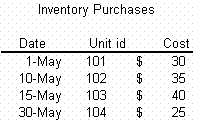CFA Level 1 - Assets
1) The Specific-identification Inventory Method
Under this inventory method each unit purchased for resale is identified and accounted for by its invoice. Companies that use this method carry a small number of units.
Cost of goods sold: $75 (ID: 102 and 103)
Ending inventory: $55 (ID: 101 and 104)
Gross profit: $300-$75 = $225
2) Average-cost Method
Under this inventory method the units in inventory are considered as a whole and their cost is averaged out. Companies that use this method carry a large number of units.
Total cost: $130
Average cost: $33 per unit (total cost / total number of units)
Cost of goods sold: $66 ($33*2 units sold)
Ending inventory: $66 ($33*2 units left)
Gross profit: $300-$66 = $234
3) First-in, First-out (FIFO)
Under this inventory method the units that were first purchased are assumed to be sold first.
Cost of goods sold: $65 (ID: 101 and 102)
Ending inventory: $65 (ID: 103 and 104)
Gross profit: $300-$65= $235
4) Last-in, First-out (LIFO)
Under this inventory method the units that were last purchased are assumed to be sold first.
Cost of goods sold: $65 (ID: 103 and 104)
Ending inventory: $65 (ID: 101 and 102)
Gross profit: $300-$65 = $235







0 comments:
Post a Comment